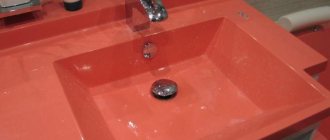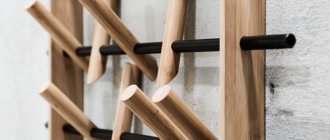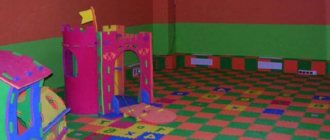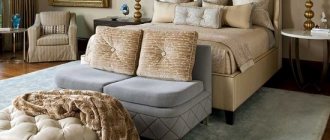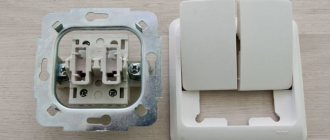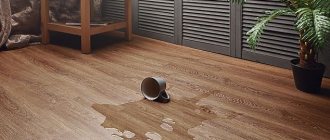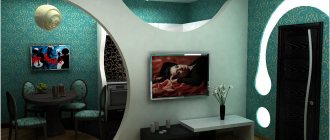A DIY clothes hanger is a fruitful idea. Theater begins with a hanger; house too. In the sense of spirit, eh. The reason is simple: the first thing a guest looks for is where to hang his outerwear. And if the hanger is clearly homemade, but comfortable, stable and durable, the owner is guaranteed a positive reputation.
The second argument for making a hanger with your own hands is prosaic: purchase prices are clearly disproportionate to production costs. A homemade clothes hanger will allow you to save an amount that is quite visible in your budget. It’s not difficult to make, you only need a little material, and waste from repairs will also be used. In most cases, the tool can be used manually.
These factors are especially felt if a floor hanger fits in the hallway. In addition, it can also serve as a dryer if its design is framed, see below, because On such hangers it is convenient to hang clothes on hangers, and the hanger itself moves away from the wall. If you managed to fence off a dressing room in your house, then a floor hanger is the best option. The cost of floor hangers is significantly higher than wall hangers, but there is nothing in the design that would prevent you from making a floor hanger yourself.
On the floor or on the wall?
What has been said is already enough to make a choice, as long as there is enough floor space. However, let’s finally look at what makes a floor-type hallway hanger so attractive:
- Clothes hung on hangers dry faster and do not stretch; The collar and lining do not tear.
- On a hanger approx. wide. 1.5 m will fit a seasonal set of clothes for the whole family, which will save on closet space and space for it.
- A shoe rack is naturally attached to the floor hanger, which simplifies the work of equipping the hallway and saves its space.
- With the correct dimensions of the hanger, neither the wall from clothes nor the clothes against the wall are damaged.
- The mobility of the hanger does not interfere with rearranging furniture; After moving the hanger, there is no need to seal the mounting holes in the wall.
However, there are different floor hangers, and not all of them are most suitable for residential premises. For example, for order (from the old Russian “order” - office, office, office) floor lamp hangers, pos. 1-4 in Fig., hanging clothes on hangers is inconvenient. Due to the small support area, they are rolly, especially when loaded with wet winter clothes. To emphasize the functional inferiority of the product, such hangers are called hangers, and they are often sold under this name.
Types of floor hangers
The best option is the same theatrical wardrobe frame hanger, pos. 5 . When designed for residential premises, it is supplemented with shelves for hats, shoes and gloves/scarves; possibly with an additional tie rod, pos. 6. Disadvantage – the “legs” of the hanger get tangled under your feet. In an attempt to get rid of it, they came up with hangers - frames on a stand, pos. 7, but generally speaking, they are even more rolls than ordered hangers. Another option is a frame hanger without legs, leaning against the wall; We will remember this one again. There are also folding frame hangers, but they have almost no advantages in everyday life.
If space is generally tight in the hallway, then a wall hanger is still more suitable. Simple wall hanger-sconce, pos. 1 in Fig., is as compact as possible, but no more convenient than an orderly one, except that it won’t fall to one side from the next jacket. Hanger-shelf, pos. 2, will not fall off if attached properly, and hats/caps from it too, but the wall and clothes rub against each other.
Types of wall hangers
Wall hanger-panel, pos. 3, saves the wall, but not clothes. Leather items wear out the most on such hangers. Tanners jokingly advise: how can you tell a sheepskin coat made from full-grain leather from one made from reverse leather? The first one, with everyday use of the panel hanger, loses its appearance in 2 winters, and the second - in half a winter. Considering the cost of genuine leather products, this is no good. Therefore, wall hangers for expensive items are often equipped with soft upholstery, pos. 4. As for wall hangers with openwork panels, pos. 5, then in this case its meaning is only decorative: it does not protect either things or the wall.
Floor hangers with chest and banquette
There are also floor hangers-panels with a stand, for example. in the form of a cabinet, chest or chest, pos. 1 in Fig. on right. This is not the best option: someone will someday put something on the lid, and the clothes being removed from the hanger will knock it onto the floor. Much more practical are floor hangers-panels with a bench, pos. 2. A flower under the seat is a matter of taste for the owners, if only it survives there, but a shoe rack or a chest for accessories for its care is in the drawer of the banquette.
Clothes and keys
Regarding panel hangers, the amateur craftsman has an additional opportunity, namely: to equip such a side panel on the edge farthest from the front door. Perhaps not reaching the bottom, with a bevel or notch. Factory ones don’t do this: the hanger should be designed for clothes to stick out from the side. One sidewall almost does not interfere with this, but it is unknown how the hanger will sit with the buyer, and making right and left hangers is expensive.
What does this add-on provide? A place for a key holder, invisible from the threshold. There, on the side, there may be a dressing table or a cabinet, but the main thing is that the owner’s keys will not catch the eye of a casual visitor, and they are in plain sight, as criminologists say, a serious factor in spontaneous illegal actions, without which, i.e. temptation, a visit from a not entirely trustworthy subject would have turned out well for both the hosts and him. You can, of course, make a luxuriously designed key holder with a secret lock, but this is a lot of work and costs for materials. Otherwise, a simple board with hooks will do. Or just hooks screwed to the side of the outside of the storage section.
Let's assume that a suitable design has already been chosen, and let's move on to how to make a hanger. Preferably wooden: the material is noble, natural, easy to process. Let's not forget other versions; in some cases more convenient. Let's start with floor hangers as the most functional.
Criterias of choice
The choice of a specific sample depends primarily on the size of the room where it is supposed to be installed. If the apartment's hallway is combined with a corridor or has an entrance vestibule layout, then the apartment owner is involuntarily forced to purchase the smallest model - usually a single-post product.
A wide or elongated hallway allows you to consider various types of two- to four-post samples or hanger rods, photos of which are shown below. The stability of floor models allows you to place a fairly large number of pieces of outerwear.
On a note!
When installed in a spacious hallway of floor-standing models, they become an excellent addition to the existing cabinets or wardrobes in this room. If cabinet furniture is used for permanent storage of clothes, then a rack hanger can be successfully used when changing clothes or hanging coats and jackets during a lunch break or when getting ready to go to the store or for a walk.
When choosing a product, the material from which the furniture is made is also important. Today it is quite difficult to find purely wooden models. Most of these products are made using a combination of different materials, and the definition of “wood” or “steel” depends on which material is more noticeable.
Many wooden hanger rods have a metal top crossbar, which, due to the perceived load from a large number of outerwear, initially implies the use of a material of increased strength.
Often in furniture supermarkets there are samples with a metal stand mounted on a wooden cross support or with wooden cross-shaped cantilever crossbars in the upper part, where it is convenient to hang just clothes using fixed hooks, as well as jackets, raincoats or jackets on hangers.
Today, in the production of devices for hanging and storing clothes, almost all parts made of metal are decoratively anodized or powder coated in a metallic color.
For children's rooms, it is better to choose a completely wooden model, painted in bright, festive colors, in the manufacture of which no metal is used, and the only “foreign” parts are plastic coat hooks.
Models made of solid wood will harmoniously fit into the interior design of the hallway, made in a classic style. Products look especially good in a “retro” design, where individual elements - racks, supports, crossbars and crossbars are decorated with carvings. Moreover, carved bas-reliefs are not necessarily carved from wood. Many manufacturers use it to decorate their products. use plastic parts “like wood”.
The color scheme of floor samples made of wood or its imitation depends primarily on the general style of the room. In the bedroom, models painted white or fawn and beige undertones would be appropriate. It is advisable to place samples of dark colors in the hallway. If natural wood or its imitation is used, then shades of “bog oak”, “ebony” or “mahogany” are quite appropriate.
Floor-standing
Those who love to craft from the heart and have a wood milling tool at their disposal can immediately take up a floor-mounted frame hanger with legs. Made from fine-grained hardwood (oak, beech, hornbeam, walnut, birch), it looks luxurious and takes up only 360 mm of floor space.
A suit hanger works well as a prototype, you just need to make it taller and move the trouser bar up so you can hang hangers on it. Instead of a tie rod and handles, you can install a shelf, and a shoe rack is mounted below. Drawings of such a hanger are shown in Fig.:
Drawings of a wooden floor hanger
With the other dimensions indicated, the structural and overall width (sizes 430 and 460 respectively) without compromising strength and stability can be increased by 1-1.4 m, i.e. the hanger will be narrower than family width up to more than 1.8 m. Self-orienting wheels, if full mobility is needed, can be installed without problems.
About hooks and traps
Bags, umbrellas, scarves are also left on the hanger, and a bachelor’s skirt and lingerie may also be there. Sometimes life is life. It is also more convenient to hang clothes on hooks for a short time. Therefore, in frame hangers, sometimes slider hooks are put on the main rod (formerly the trouser rod in Fig; height 1360). They or the hangers, depending on the need, are moved to the side en masse. But the sliding hooks under the fingers turn out at the most inopportune moment. In a hanger of this design and similar ones, the problem is solved simply: the main rod is for hangers, and the fixed hooks are attached to the top board.
Pipes and profiles
Original hangers are made from round or profile metal or plastic pipes, see fig. However, despite all the design tricks, their organic defects do not disappear. The same ones that hanged the orderly. But it adds high labor intensity: in order to hide the connecting nodes, you have to really strain both your hands and your head.
Pipe hangers
It is better to make a square base for a floor lamp hanger from pipes. With the same floor area removed, the distance between the support points increases by 1.4 times. If you make the base even heavier, a hanger up to 1.7 m high turns into a full-fledged hanger. 60 mm sewer pipes are most suitable.
A short master class in pictures on making the base of a floor hanger from pipes is shown in the following. rice. Pipe sections are 150-300 mm, depending on how much floor can be given to the hanger. In addition to them, you will need 3 straight tees, 4 right angles and 4 plugs. Connections are made using propylene or PVC glue, depending on the pipe material. Weighting - sand or small crushed stone.
Making the base of a hanger from pipes
One of the comments on the original design begins with a question like this: “Why couldn’t you just solder it?” Judging by the fact that later in the same comment the 90° angles are called bends with an obvious claim to professionalism (plumbing bends are oblique tees), 2-3 more and the same number of exclamation marks suggest themselves in addition to the question mark.
Nevertheless, the author of the product, even if she did not know plumbing terminology, solved the problem quite like an engineer. The hanger doesn't need sealed joints, and a tube of glue will cost much less than renting a soldering iron for propylene. Which you also need to learn how to use, spoiling a lot of the material. For greater reliability, you can reinforce the connections with phosphated (black) self-tapping screws: their heads are not visible on black, and the strength of the hanger will not be reduced.
Note: the top in the original design is also made of pipes, but its design, frankly speaking, is not that... It would be better to drill inclined holes in the rack and insert some strong pins into them using the same glue; wooden, metal.
Simple frame
Scheme of a simple floor-wall hanger made of pipes
A frame hanger made of pipes can be without legs, simply leaning against the wall at an angle. However, its slope must be negative. There should be at least 350 mm between the wall and clothes on hangers. If the tilt of the frame is positive (the upper crossbar is adjacent to the wall), then the lower one will “move away” from the plinth by 500-600 mm. In a small hallway this is a serious inconvenience. In addition, they will either cling to the bottom crossbar with their feet and it will break the floor, or they will have to fasten it to the floor, and this is really bad: any violation of the flooring is fraught with complex and expensive emergency repairs. Have you ever seen furniture on sale that needs to be screwed to the floor? Unless for special purposes, for example. rack. And then, they also try to make do with fastenings to the walls and, in extreme cases, the ceiling.
The diagram of a frame hanger with a negative slope made of pipes is shown in Fig. The materials are the same: sections of straight sewer pipes 60 mm, 90 angles and straight tees. The usable floor area taken away is zero. Below there can be a shoe rack or a banquette. For fastening to the wall, so as not to drill a lot and do without expensive collet anchors, it is better to take a couple more tees: with their help, the holding beams - guy wires - are attached to the wall with a pair of self-tapping screws in dowels each.
Types of costume hangers
The traditional version of the valet hanger is a floor-mounted structure on two supports with hangers for a jacket and a crossbar for trousers, and is usually located in the bedroom. This is an item for individual use; each family member should have their own “valet”.
There are improved versions of hangers that increase the ease of use. In a small room, you can use a folding hanger, place things on it after ironing or when preparing to leave the house, and store it in an inconspicuous place the rest of the time. The hanger can be equipped with wheels for easy movement around the apartment.
Related links: How to correctly place accent points in the interior of an apartment
Hangers can also be designed for women's clothing. In this case, it has clips for skirts and dresses. In dressing rooms and hallways, suit hangers with open shelves for shoes or combined models with built-in shoe racks are installed.
The best option for a study would be a hanger with a mirror. A modern vision of a hanger is a model with a built-in electric press. This “valet” will provide you with not only a jacket in the morning, but also perfectly ironed trousers.
Wall mounted
Simple panel hangers do not require any special disassembly. How to make a wooden wall hanger, see e.g. video.
Video: DIY wall hanger made of wood
Here we remember, firstly, about the sconce hanger. Folding, it can be very useful if a large company has gathered or the kids have returned from the yard.
An example of this kind of design is shown on the right in Fig. However, its creators were clearly guided by the principle: “Consumption is the basis of cash circulation.” The outer (folded) side of the flap is inactive and requires a locking mechanism. And a separate hanger for every day.
Compact folding wall hanger
Meanwhile, folding wall hangers have been known since Ancient Egypt. In the climate there, outerwear was worn occasionally, in bad weather, but after wearing it it was necessary to dry it. There was no point in keeping a separate hanger for this in areas where it rains and is cold not once a year, so they came up with one like the one on the right in Fig.
When folded, the compact Egyptian wall hanger was secured with a cypress stick. Now, of course, you can install a ball retainer or just a hook. The main thing is that the hook hooks should be 3/4 of a circle, then nothing will fall off them even with the bar folded back. And without need, the whole hanger looks like just a stick on the wall; You can hang bags, umbrellas, and keys on the hooks.
More about hooks
An original wooden hanger can be made without any metal at all, not counting the fasteners. Do not rush to throw away the New Year's pine or Christmas tree (only the blanks will need to be turned upside down):
Video: original DIY wooden hanger
Such a hanger will look best in a country house, in a timber or frame house. Depending on the interior design – even in a city apartment. It will go well in the bathhouse: touching steamed skin to metal is both unpleasant and, to some extent, even dangerous.
Hangers for the nursery
Probably all children throw away their clothes. There is no need to particularly scold them for this: without experiencing chaos within reasonable limits, you will not get accustomed to order. Who is against it - answer Friday’s question to Robinson Crusoe: “Why doesn’t the devil kill God?”
However, it is necessary to teach children to handle things properly. Only a children's hanger, so as not to cause obvious psychological rejection, should look somewhat disordered . It is also highly desirable that the child associate it with his favorite game or hobby. Examples of “game/hobby” type wall hangers for children’s rooms are given in pos. 1 and 2 fig.
Children's hangers
A universal method of this kind is a tree hanger, pos. 3. In the contour of a tree, as in any fractal structure, order and chaos interact and complement each other, giving rise to a harmonious whole. Just don’t forget to make the wood stronger, e.g. from plywood from 12 mm, and properly, in increments of no more than 250-300 mm, attach to the wall with self-tapping screws from 6 mm in propylene dowels. A tree is meant for climbing.
Floor hangers in a nursery are undesirable for the same reason: well, they will climb anyway and crash. Therefore, if you want a floor hanger for the nursery, you need to make one that you can’t fit on, as can be seen in pos. 4 and 5.
About cutting plywood
In any case, parents are faced with problems that little ones don’t care about yet: material consumption and labor intensity. Drawing a complex contour along a grid on a single sheet of plywood is no longer easy; then you need to cut it out precisely, which is even more difficult. And in the end it turns out that 60% or 80% of the material went to waste, no longer suitable for anything. On the contrary, you need to make a children's tree hanger from waste. Or cut a whole sheet more tightly.
Assembling parts of a wooden hanger from plywood
The method for this has long been known: element-by-element cutting and assembly. If the tree is plywood, for complete strength of the finished product, each part is assembled from 2 layers, leaving the corresponding folds and grooves, see fig. Fragments of blanks are assembled using PVA glue, wood glue or “Express” (liquid nails). If the assembly is made of PVA, the fragments must be additionally fastened with small snake nails in increments of 100-150 mm with a distance of 30-40 mm from the edges.
The wooden hanger is assembled using the same adhesives, but now each connection must be secured with wood screws and an envelope. Then the gaps and fastener heads (they need to be recessed during assembly) are rubbed with putty made from sawdust of the same plywood on PVA. Such wood will look solid even without painting, only under varnish.
Note: just in case, let us remind you that before assembly, all wooden parts of any wooden hanger must be sanded with fine sandpaper and treated with a water-polymer emulsion or PVA diluted three to five times with water. After impregnation, before further work, a technological break is taken until the part is completely dry (1-3 days, depending on its size).
Features of the valet hanger
When choosing a valet hanger, you should pay attention to the nuances of its manufacture:
- The hangers must be perfectly smooth and polished.
- The width of the trouser bar should be sufficient for trousers of any style.
- For items made of silk and other smooth fabrics, hangers should be made of non-slip material.
Related links: Decorative stone in interior design
A valet hanger in a modern design can be not only a functional item, but also a unique decorative item. Elite options are made from expensive wood and chromed steel, come in a variety of colors, and have a sophisticated or futuristic design. The valet hanger is a practical and stylish solution to the problem of storing your daily suit.
And one last thing about hooks
In the illustrations above, you most likely noticed the curved wooden hooks and other details of the hangers. It is quite possible to make them at home. In production, dense, fine-grained, defect-free wood or waterproof birch plywood (BS grade) is bent by heating with steaming or dry, but for home work these methods are too complicated. Only bamboo is steamed more or less simply: the workpiece is boiled for half an hour or an hour in rapidly boiling water, after which it is bent by hand. In the case of bending according to a template, the workpiece must be quickly tied to it, before it has cooled down, with a wide cotton braid or a strip of natural tarpaulin.
Wood rasp
At home, it is easier to cut blanks of the required configuration from a sheet of plywood (any) or MDF of the required thickness or, twice or four times as much in quantity, from thin sheet material, in order to then collect as much thickness as required. Cut with a finishing allowance of approx. 1 mm. The cut blanks are tightly pulled together in a package in a carpenter's vice or in a mechanic's vice through spacers made of thick plywood and processed with a wood rasp to size, and then sanded clean. One rasp is enough, with flat and semicircular working surfaces, see fig.
The blanks are assembled into parts using the method described above. The end surfaces, if it is necessary to hide the layered structure of the plywood, are sealed with strips of self-adhesive wood-like film. After this, the part is varnished two or three times with water-based acrylic varnish; nitro varnish can damage the self-adhesive. There is no point in edging (edging) with a plastic furniture edge: you need to accurately select the groove for the edge anchor, which requires a milling machine, but on curved surfaces of great curvature and short length, the edge still does not hold well. And parts covered with self-adhesive tape, varnished, and solid wood cannot be immediately distinguished even by a master cabinetmaker.
Source
(Visited 21,674 times, 1 visits today)


